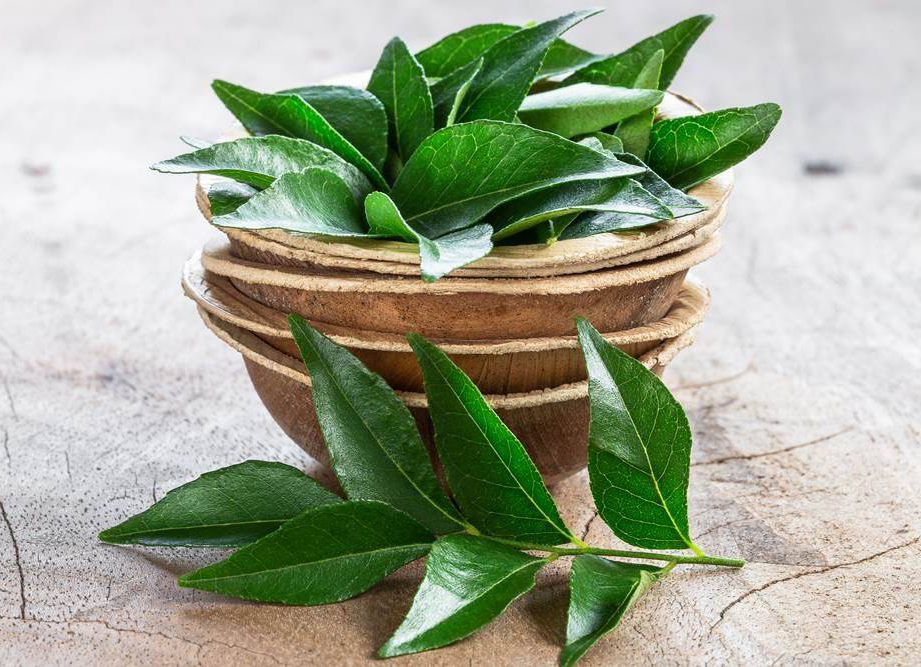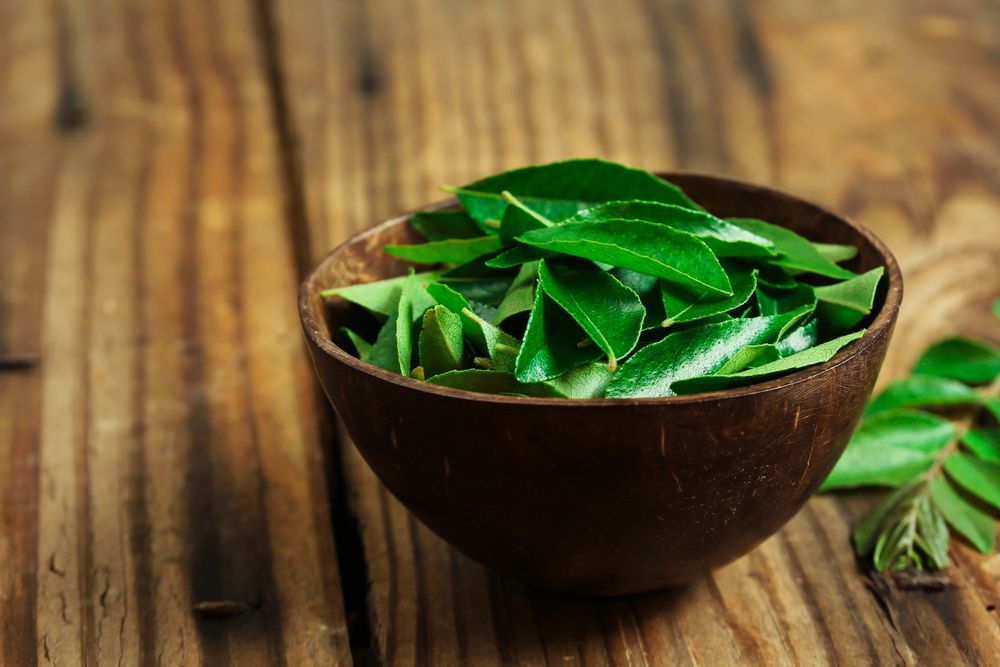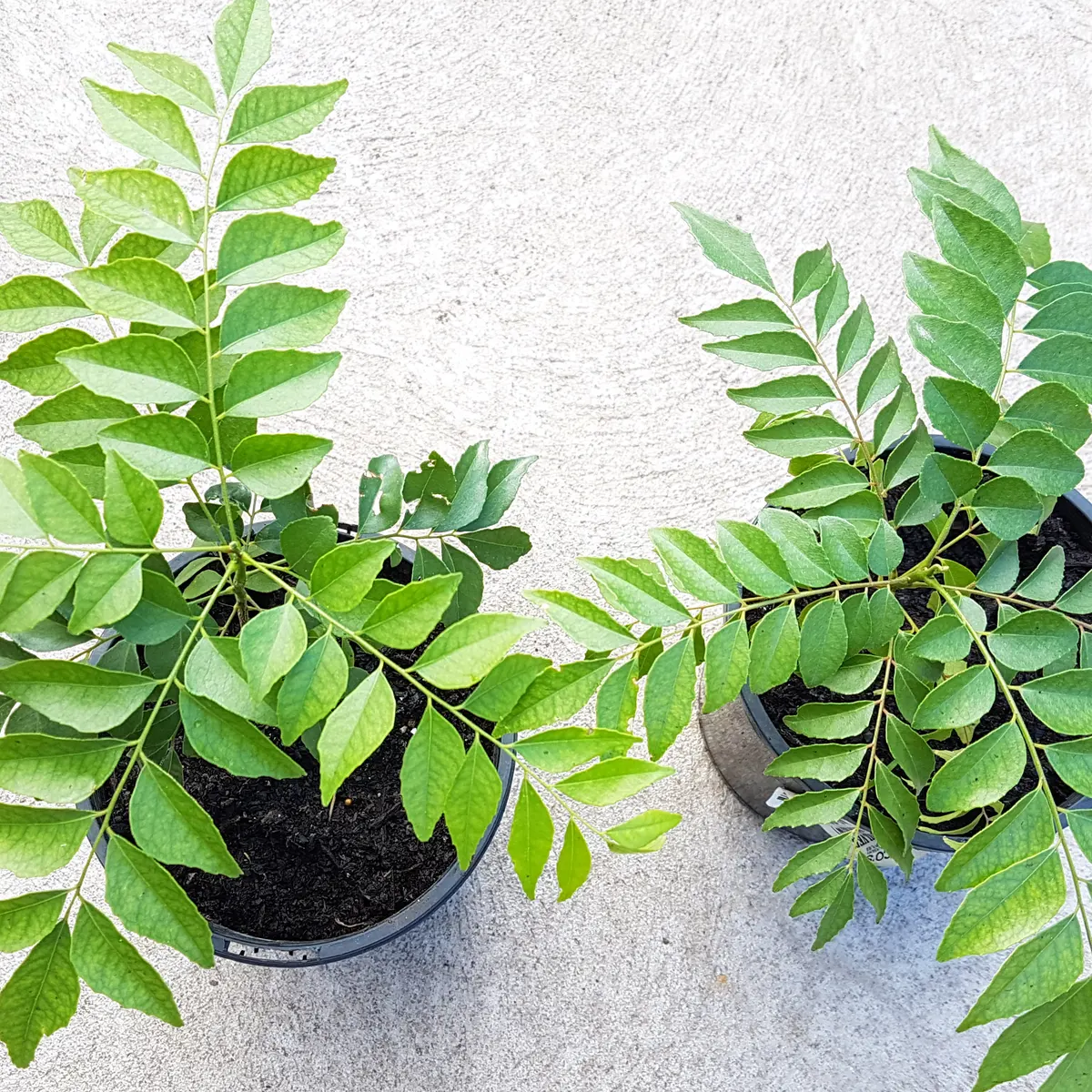
Curry Leaves have an important place in all Indian food and dishes. Apart from the flavor it also provides immense health benefits. The curry tree is a tropical to sub-tropical tree in the family Rutaceae (the rue family, which includes rue, citrus, and satinwood), which is native to India and Sri Lanka. The leaves are highly valued as seasoning in southern and west-coast Indian cooking, and Sri Lankan cooking especially in curries, usually fried along with the chopped onion in the first stage of the preparation. They are also used to make thoran, vada, rasam and kadhi. In their fresh form, they have a short shelf life and do not keep well in the refrigerator. They are also available dried, though the aroma is largely inferior.
The leaves of Murraya koenigii are also used as an herb in Ayurvedic medicine. They are believed to possess anti-diabetic properties. Although most commonly used in curries, leaves from the curry tree can be used in many other dishes to add flavor. In Cambodia, Khmer toast the leaves in an open flame or roast it until crispy and then crush it into a soured soup dish called Maju Krueng
Its leaves are used in many dishes in India and neighbouring countries. Often used in curries, the leaves are generally called by the name ‘curry leaves,’ although they are also literally ‘sweet neem leaves’ in most Indian languages.
Curry leaves are natural flavouring agents with a number of important health benefits, which makes your food both healthy and tasty along with pleasing aroma. They contain various antioxidant properties and have the ability to control diarrhea, gastrointestinal problems such as indigestion, excessive acid secretion, peptic ulcers, dysentery, diabetes and an unhealthy cholesterol balance. They are also believed to have cancer fighting properties and are known to help protect the liver.

Scientific Information: The scientific name of the curry plant is Murraya Koenigii Spreng and it belongs to the Rutaceae family. The plant is native to India and is usually found in tropical and subtropical regions. It is cultivated in various other countries such as China, Australia, Nigeria and Ceylon. Height of the plant ranges from small to medium. The most useful parts of this plant are the leaves, root and the bark.
In Ayurvedic medicine, curry leaves are believed to have several medicinal properties such as anti-diabetic, antioxidant, antimicrobial, anti-inflammatory, anti-carcinogenic and hepato-protective (capability to protect liver from damage) properties. The roots are used for treating body aches and the bark is used for snake bite relief.
The leaves, with their vast herbal properties, are used in various local cuisines across India and other parts of Asia as flavoring agents. Curry leaves resemble ‘neem’ or Indian lilac and their name in most Indian languages translates to ‘sweet neem’.
The main nutrients found in curry leaves are carbohydrates, energy, fiber, calcium, phosphorous, iron, magnesium, copper and minerals. It also contains various vitamins like nicotinic acid and vitamin C, vitamin A, vitamin B, vitamin E, antioxidants, plant sterols, amino acids, glycosides and flavonoids. Also, nearly zero fat (0.1 g per 100 g) is found in curry leaves.
Leaves include carbazole alkaloids. Research studies held by the Department of Home Economics at Kenmei Women’s Junior College in Hyogo, Japan showed that alkaloids found in curry leaves possess antioxidant properties. Carbazole alkaloids include mahanimbine, murrayanol, mahanineoenimbine, O-methylmurrayamine A, O-methylmahanine, isomahanine, bismahanine and bispyrayafoline. . Further studies conducted at the Department of Horticulture at Michigan State University suggested that these chemicals had insecticidal and antimicrobial properties as well, specifically mosquitocidal properties.
Health Benefits of Curry Leaves
Most people think that curry leaves just add flavor to the food and they throw the leaves away while eating eating their soup or curry. However, curry leaves are far more important than many people realize, and they offer a number of health benefits without the side effects of other medicines.
Stops Diarrhea: Research studies conducted by Ashish Pagariya and Maithili, V. concluded that the carbazole alkaloids present in curry leaves or Murraya Koenigii had anti-diarrheal properties. Experiments on lab rats showed that carbazole extracts from curry leaves had significantly controlled castor oil-induced diarrhea. A bunch of curry leaves can be ground up and the paste can be eaten or the juice of the leaves can be consumed.

Gastrointestinal Protection: Use of curry leaves is recommended as a cure for gastrointestinal issues in Ayurvedic methodology. One important is due to the fact that they are considered to possess mild laxative properties. Make juice out of a bunch of curry leaves and add lime juice. This mixture is to be consumed for indigestion or a paste made from the leaves can be added to buttermilk and taken every morning on an empty stomach.
Antioxidant Properties: Research studies conducted by Mylarappa B. Ningappa et al. at Jawaharlal Nehru Center for Advanced Scientific Research, Molecular Parasitology and Protein Engineering Laboratory in Bengaluru, India have indicated that curry leaves or Murraya Koenigii is a good source of antioxidants. The presence of various vitamins like vitamin A, B, C and E help in reducing oxidative stress and free radical scavenging activity. Curry leaves can be added to your curries, vegetable stews and soups. They are also available in dried powder form.
Anti-Diabetic Properties: Perhaps one of the biggest health benefits of curry leaves is its use in diabetes control. Research conducted by the Department of Biochemistry and Molecular Biology at University of Madras, Chennai had shown that the anti-hyperglycemic properties of curry leaves were beneficial in controlling blood glucose levels in diabetic rats.
Fights Cancer: The chemical constituents found in curry leaves such as phenols are helpful in fighting cancers such as leukemia, prostate cancer and colorectal cancers. Research on curry leaves at the Department of Medical Chemistry at Mejio University, Japan showed evidence of cancer fighting properties in the carbazole alkaloids extract from curry leaves.
Lowers Cholesterol Levels: Curry leaves are also known to reduce bad LDL cholesterol level. Studies conducted at the Department of Biochemistry at the University of Kerala, India have shown that curry leaves have the potential to reduce LDL cholesterol levels.
Good for Hair Growth: Curry leaves are believed to help in strengthening hair roots. Dry curry leaf powder mixed in oil can be applied to your hair with a quick massage. The paste from curry leaves can also be applied in cases of gray hair. Doing these on a regular basis can improve hair growth as well.
Good for Eyesight: Curry leaves contain high amounts of vitamin A and are therefore good for eyesight. Vitamin A contains carotenoids which protect the cornea, which is the eye surface. Deficiency of vitamin A may cause night blindness, cloud formations in front of the eye and even the loss of vision loss in some cases.
Radio-Protective and Chemo-Protective: Studies on the extracts of curry leaves have shown positive results in reducing the effects of chemotherapy and radiotherapy, while also offering protection against chromosomal damage, protection of bone marrow and prevention of free radicals becoming active in the body.
Protects Against Pathogen Attack: Research on curry leaves has revealed that they are also effective in fighting bacterial and fungal infections. The leaf extracts from the plant have been comparable to popular, mainstream antibiotic drugs.
Protects the Liver: Your liver plays a major role in the digestive system and it needs to be protected from any attack by free radicals, as well as viral and bacterial attacks that can result in infection. Research on curry leaves has indicated that the tannins and carbazole alkaloids present in curry leaves exhibited good hepato-protective properties. They are also helpful in protecting the liver from various diseases such as hepatitis and cirrhosis.
Skin care: Curry leaves are also helpful in skin care. The juice or paste of the leaves can be applied on burns, cuts, bruises, skin irritations and insect bites for quick recovery and clean healing.
Disclaimer
The Content is not intended to be a substitute for professional medical advice, diagnosis, or treatment. Always seek the advice of your physician or other qualified health provider with any questions you may have regarding a medical condition.